
At the
time when George Washington took
command of American forces in 1775
at the outset of the American
Revolution, he was virtually unknown
outside the colonies, and even
within the colonies he was but one
of many patriots supporting the
cause. By the time of his
death in 1799, less than 25 years
later, he was known throughout the
western world for his primary
leadership role in establishing the
United States of America.
During this time, portrait artists
flocked to Washington to paint his
likeness, and engravings of
Washington were published far and
wide. Some of the earliest
engravings look nothing like
Washington because the artists and
engravers had no image of him to
base their likeness on; thus they
simply made his likeness up.
Others engraved from paintings of
Washington by John Trumbull or
Charles Willson Peale, who
themselves made multiple copies of
their paintings. Engravers
copied other engravings, and thus
there are groupings of early
Washington engravings that are based
on a particular early subject, such
as those after
Charles Willson Peale or Edward
Savage.
By the
19th century, collectors began to
collect and catalog the engravings
of Washington, organizing them based
on their rarity and the lineage of
their likenesses. Scholars such as
William Spohn Baker and Charles
Henry Hart published books in the
late 19th century that describe the
examples they were aware of,
assigning reference numbers to them.
Today, prints of Washington are
referenced by these numbers, such as
"Hart 81" or "Baker 34". They
also approximated their scarcity,
with annotations such as "rare",
"very rare", or "exceedingly rare".
Washington engravings that date to
his lifetime, between 1775 and 1799,
and the year of mourning in 1800,
are especially sought after and
difficult to locate.
Below are several examples of rare
18th century and early 19th century
George Washington engravings held in
the Rare Flags collection.
|
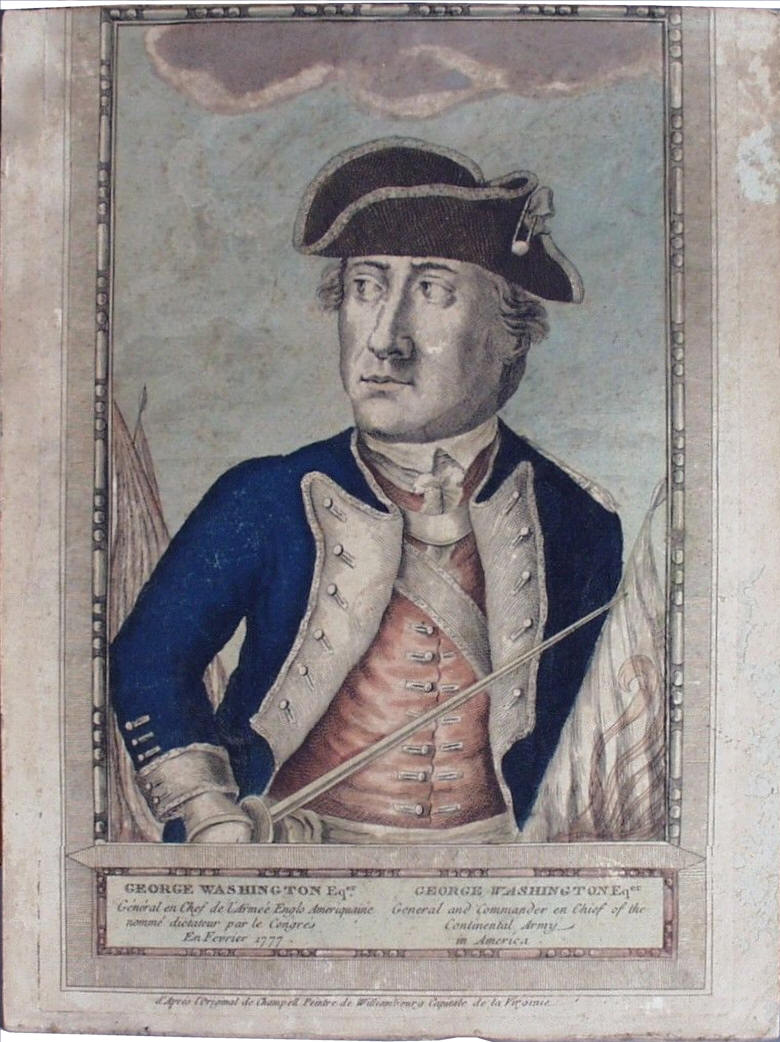 |
GEO. WASHINGTON ESQR.
George Washington Eqer.
General en Chef de l'Armee
Englo Ameriquaine nomme
dictateur par le Congres En
Fevrier 1777. : George
Washington Eqer. General and
Commander en Chief of the
Continental Army in America. The
byline of the printer reads
D'Apres l'Original de
Champell [sic] Peintre de
Williambourg Capitale de la
Virginie.
In 1777 a fictitious
rendition of George
Washington, attributed to an
unidentified painter named
"Alexander Campbell" was
engraved and circulated.
There is no record of a
painter or draughtsman by
the name of Alexander
Campbell in Williamsburg at
this time. Regarding the
drawing of Washington that
Campbell is credited as
having "Drawn from the
Life", Washington himself
wrote: "Mr. Campbell, whom I
never saw to my knowledge,
has made a very formidable
figure of the
Commander-in-chief, giving
him a sufficient portion of
terror in his countenance."
An example of the Alexander
Campbell rendition of George
Washington on horseback was
printed in Nuremburg. This
engraving of Washington
flanked by battle flags was
likely engraved and printed
in Paris, France, with
Washington's pose derived
from the Nuremberg print.
Several sources attribute
the print's origin to Paris,
and writing in French dating
to circa 1815 on the back of
this print is a strong
indication that the print
did originate in France.
Sources variably date the
engraving to as early as
1777, and as late as 1780,
making this a very early
Revolutionary War era
rendition of Washington. Baker lists the
engraving as "extremely
rare",
the Whelen Collection as "extremely
rare".
After: Alexander Campbell
Engraver: Unknown
Location: Likely Paris
Year: 1777-1780
Reference: Baker 59 |
|
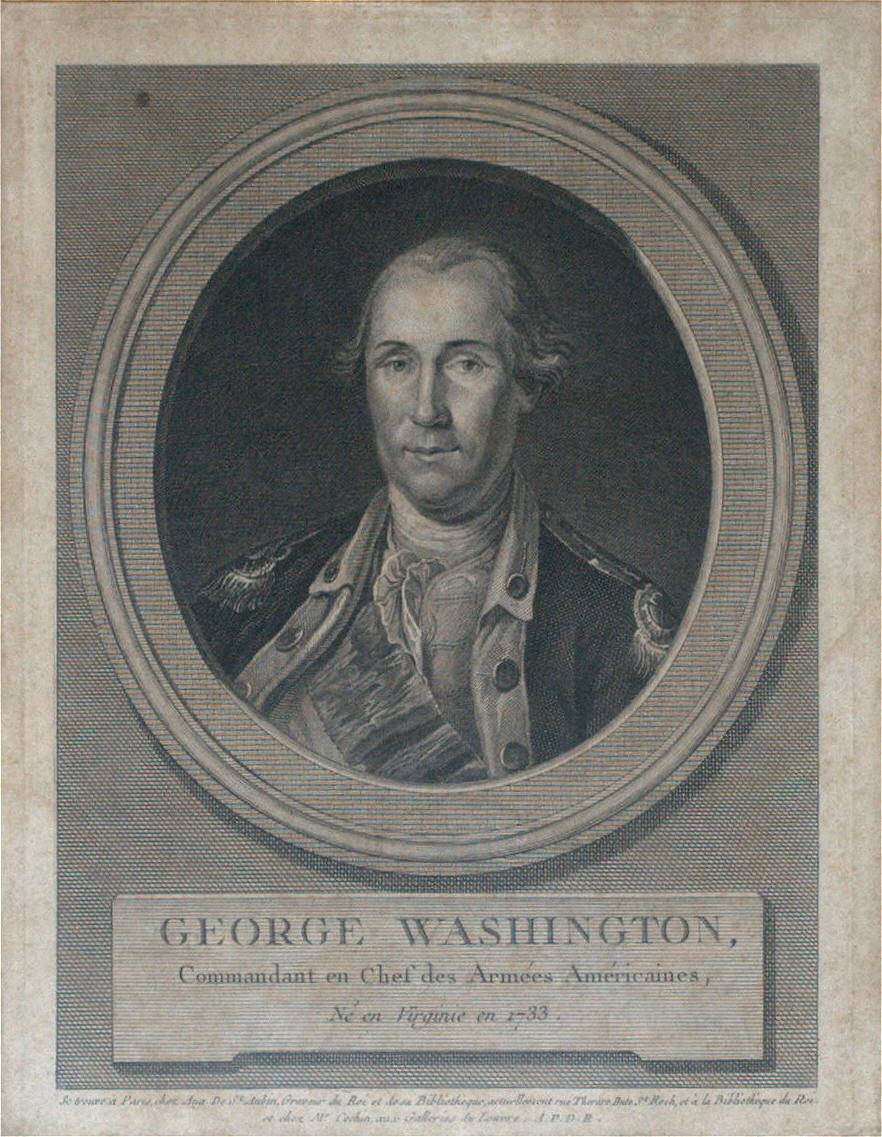 |
George Washington,
Commandant en Chef des
Armees Americaines, Ne en
Virginie en 1733.
Se trouve a Paris, chez
Aug. De St. Aubin, Graveur
du Roi et de sa Bibliotheque,
actuellement rue Therese
Bute St Roch et a la
Bibliotheque et chez Mr
Cochin, Aux Galleries du
Louvre A. P. D. R.
After Charles Willson Peale.
Engraved by Augstin St.
Aubin, published by Nicolas
Cochin, circa 1780. Baker
No. 31 "rare"; Carson No.
46; Hart No. 48.
After: Charles Willson Peale
Engraver: Augustin St. Aubin
Location: Paris
Year: Circa 1780
Reference: Carson No. 46;
Hart No. 48; Baker No. 31 |
|
 |
LE GENERAL WASHINGTON. |
COMMENDANT EN CHEF DES
ARMEES AMERICAINES. | NE EN
VIRGINIE EN 1733. | GRAVE
D'APRES LE TABLEAU DE N:
PIEHLE PEINT D'APRES NATURE
A PHILADELPHIE EN 1783.
This engraving was published
in Johann Kaspar Lavater's 4
volume book Essai sur
Physionomie, Destine a
Faire, Connoitre L'homme & a
le Faire Aimer. Lavater
was a proponent of
physiognomy, which was a
theory (controversial by the
19th century) that attempted
to correlate a person's
physical traits and facial
features with their
character, personality
traits, and abilities.
Published in Lavater's third
volume, the engraving of
Washington introduced an
American personage into this
work, and the engraving was
prepared with the engraved
vignette of the Cornwallis'
Surrender at Yorktown to
highlight Washington's
successful military
leadership. Baker, Whelen,
and Carson list this
engraving as "rare".
After: Charles Willson Peale
Engraver: Halder
Location: The Hague,
Netherlands
Year: 1783-1786
Reference: Baker 14, Hart
20a, Whelen 15, Carson 27,
Fowble 82 |
|
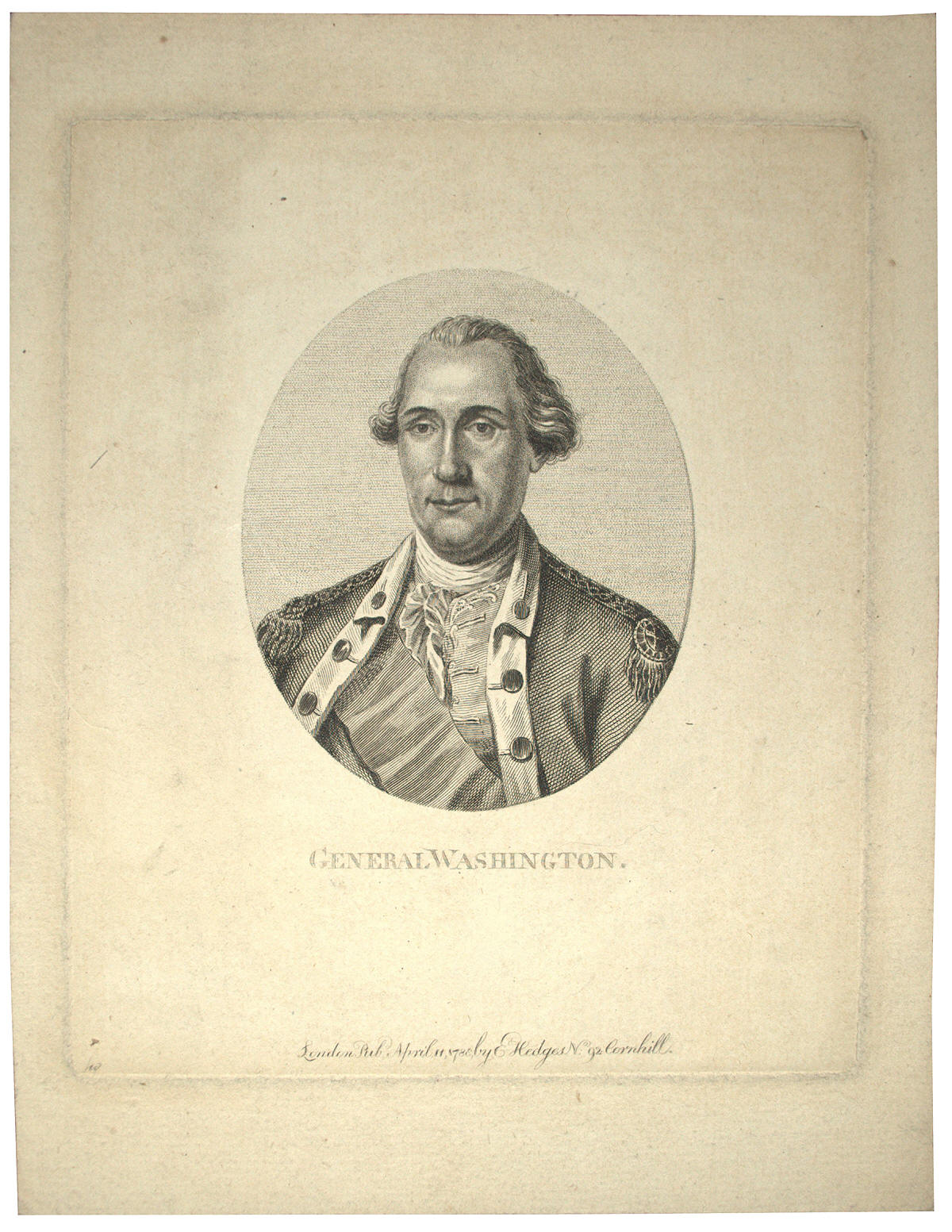 |
General Washington.
London Pub'd April 11, 1788
by E. Hedges No. 92
Cornhill. After
Charles Willson Peale's 1776
portrait. Listed in
the Hampton Carson
Collection of engraved
portraits of General
Washington as No. 64, "of
the greatest rarity"; Baker
No. 44, but unknown to Baker
because the address was cut
down, "rare"; Hart No. 52.
After: Charles Willson
Peale
Engraver: Edward
Hedges
Location: London
Year: 1788
Reference: Carson No. 64;
Hart No. 52; Baker No. 44 |
|
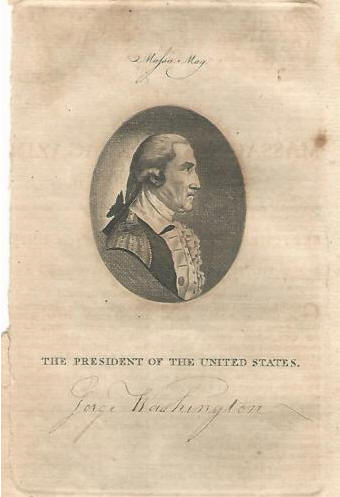 |
GENERAL WASHINGTON.
After Joseph Wright. This is another variant of
Joseph Wright's 1791
engraving of George
Washington, which was
published very shortly after
the original by Wright. It
was published by Isaiah
Thomas and Ebenezer Andrews
in the March, 1791 issue of
the Massachusetts Magazine,
indicated by the "Massa Mag"
head line. Samuel Hill,
known for his quality
engravings, many of which
were published in the
Massachusetts Magazine, is
the likely engraver of this
print. Eighteenth century
handwriting, in fine script
below the image,
personalizes the engraving
by adding "G[e]orge
Washington" (sp). Baker
lists the engraving as
"rare", without an engraver
identified.
After: Joseph Wright
Engraver: Samuel Hill
(Likely)
Location: Boston
Year: March, 1791
Reference: Baker 77, Hart
143, Wick 28. |
|
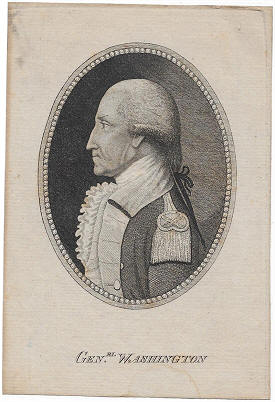 |
GEN.RL WASHINGTON.
After Joseph Wright.
This scarce engraving of
Washington was unknown to
Baker, and documented by
Hart as Hart No. 158.
One example of the type
appeared as Lot 103 from the
Whelen Collection sale in
1909, noted as "extremely
rare". Lot 148 of the
Mitchell Collection sale in
1906, also noted as
"extremely rare". Lot
184 of the Holden Collection
sale of 1910 lists the
engraving as "scarce" and
attributes the engraving to
being printed in Edinburgh
in 1791, without further
details.
After: Joseph Wright
Engraver: Unknown
Location: Edinburgh
Year: Circa 1791
Reference: Hart No. 158 |
|
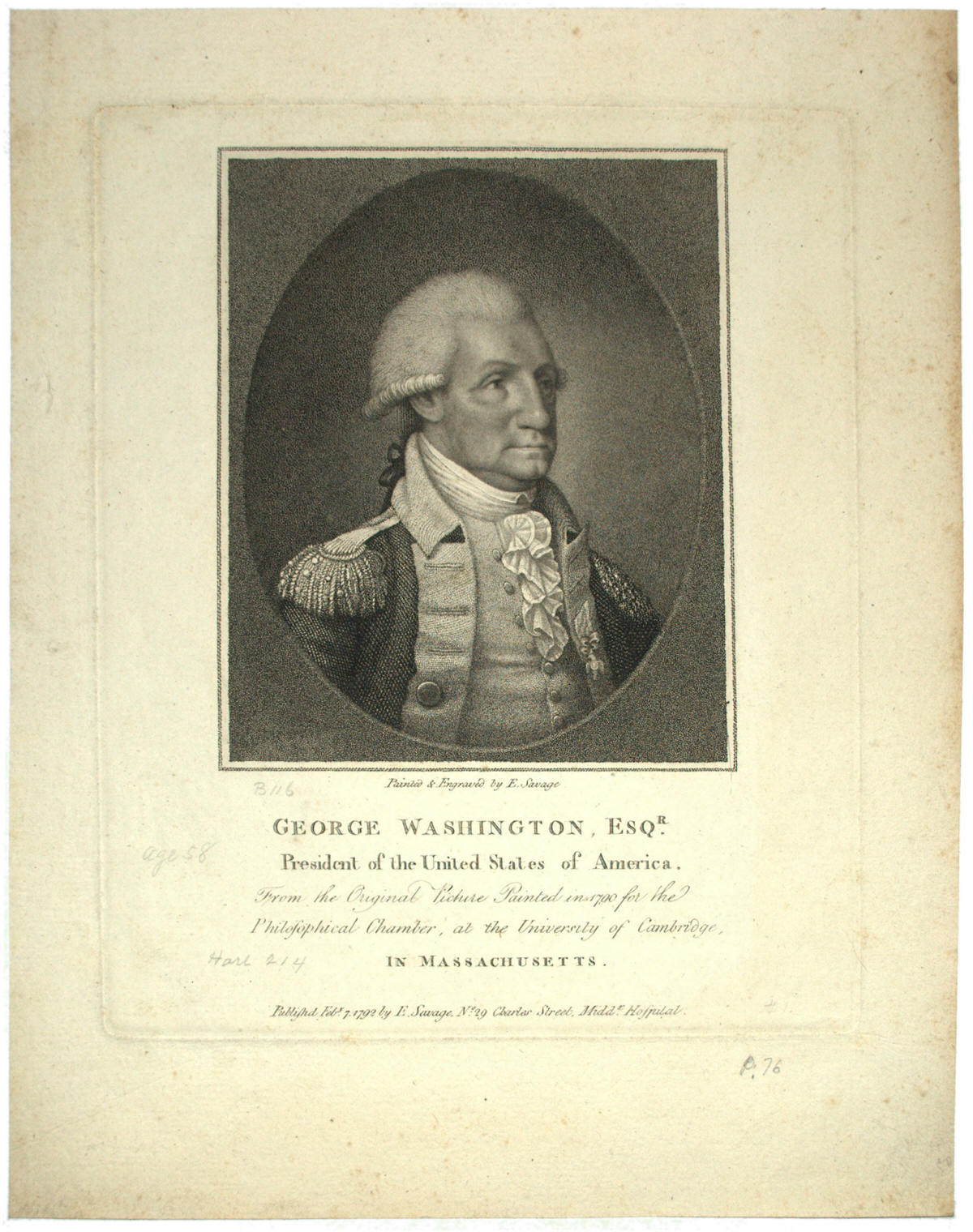 |
George Washington, Esqr.
President of the United
States of America.
From the Original Picture
Printed in 1790 for the
Philosophical Chamber, at
the University of Cambridge,
in Massachusetts.
Published Feb'y. 7, 1792 by
E. Savage. No. 29 Charles
Street, Middx. Hospital.
Published by Edward
Savage, who is also the
portrait artist for this
likeness. Scholars are
not certain if Savage
actually engraved the
portrait, or if an unnamed
London engraver assisted or
engraved the plate.
Hart No. 214; Baker No. 116
"very rare"; Carson No. 240.
This print is a superb
impression with full, wide
margins.
After: Edward Savage
Engraver: Edward Savage
Location: London
Year: 1792
Reference: Carson No. 240;
Hart No. 214; Baker No. 116 |
|
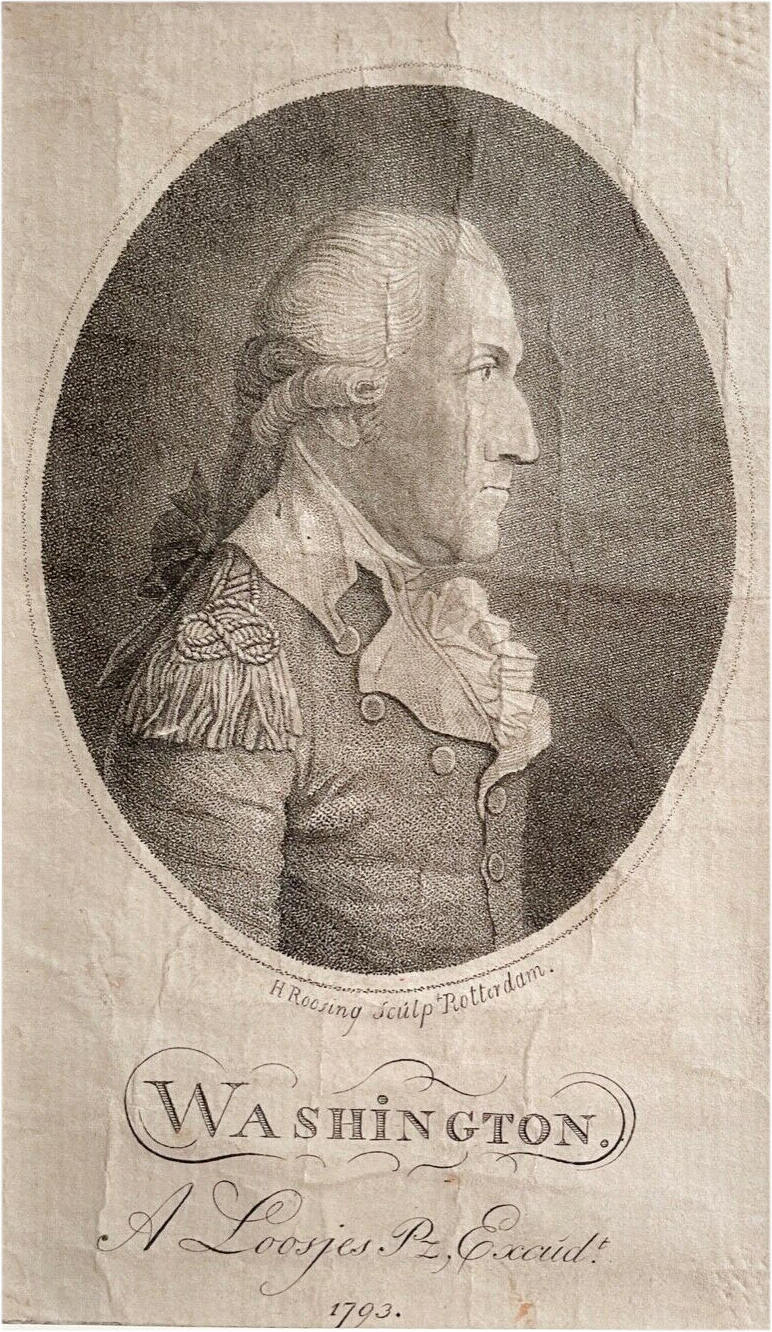 |
WASHINGTON, A Loosjes Pz
Excudit, 1793.
H Roosing Sculpt,
Rotterdam. This
variation of Joseph Wright's
portrait and engraving of
Washington was printed in
1793, during the first year
of Washington' second term
as President of the United
States. This is another of
the European engravings
after the Wright portrait
engraved and published in
the 1790s. Baker lists this
engraving as "very rare";
Whelen and Carson
collections list the
engraving as "rare".
After: Joseph Wright
Engraver: Roosing
Location: Rotterdam
Year: 1793
Reference: Baker 94, Hart
170, Whelen 98, Carson 159. |
|
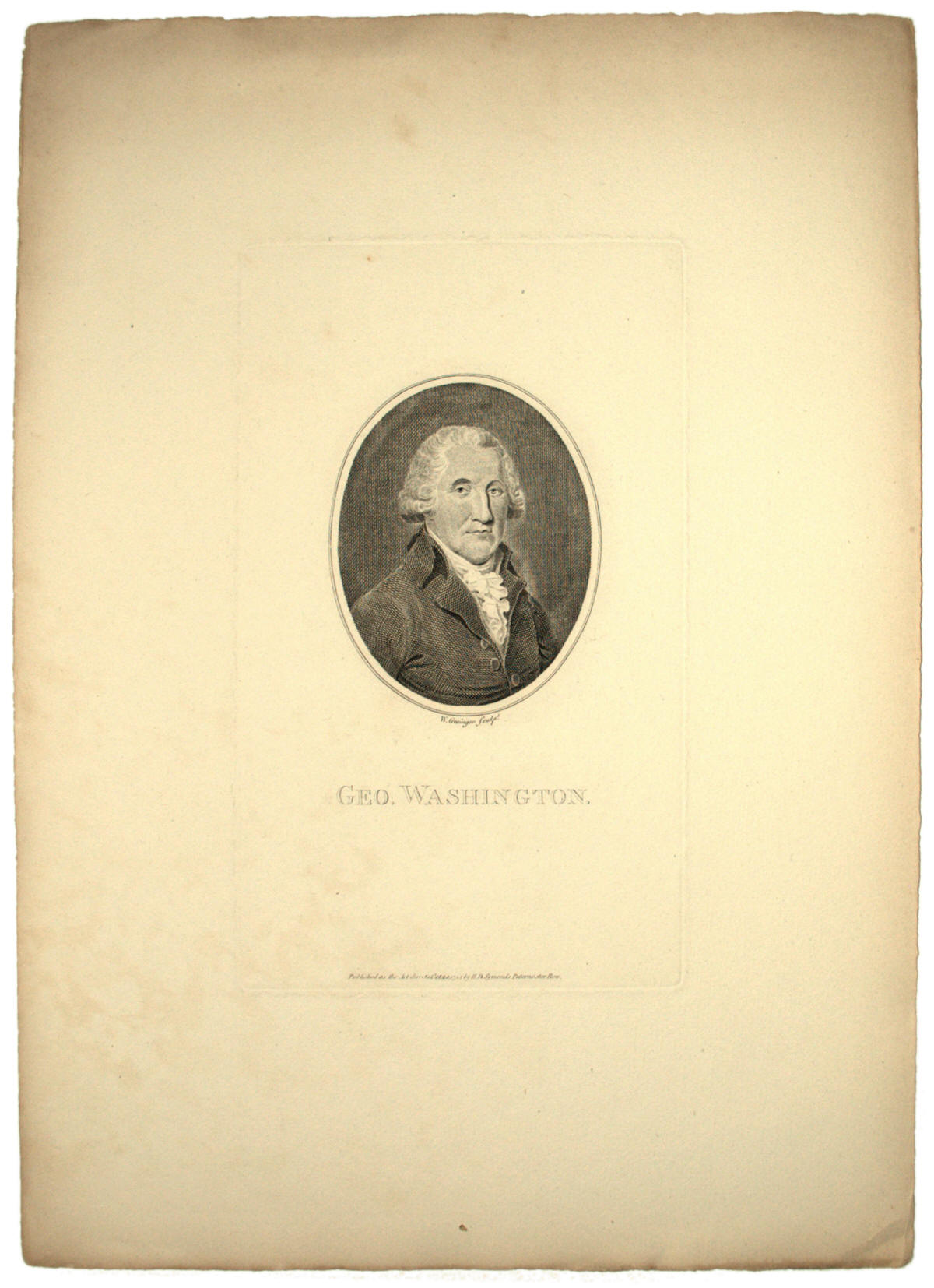 |
Geo. Washington.
W. Grainger Sculpt,
Published as the Act directs
Oct. 25, 1794 By H. D.
Symonds Paternoster Row.
After Archibald Robertson.
George Washington is
President of the United
States at this time, and is
depicted in civilian dress.
Baker No. 164; Carson No.
338E; Hart No. 806.
Baker and Hart list this
print as belonging to a
book, "View of the United
States. By W. Winterbottom.
London, 1795". The
dimensions of the prints
cited by Baker and Hart are
small, indicating that they
were only aware of the book
printed versions of the
Grainger prints. This
is a very rare full sheet
printing with original wide
margins, 14" x 10" unknown
to Hart or Baker.
After: Archibald Robertson
Engraver: W. Grainger
Location: London
Year: 1794
Reference: Carson No. 338E;
Hart No. 806; Baker No. 164 |
|
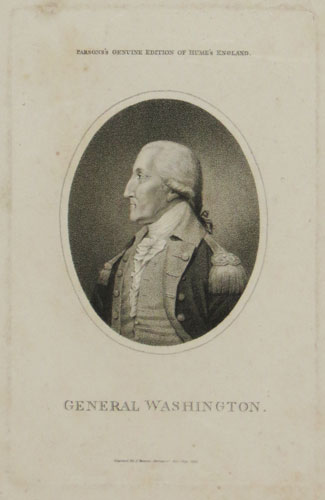 |
GENERAL WASHINGTON. Parson's
Genuine Edition of Hume's
England, Engraved for J.
Parsons, Paternoster Row,
May 1795. This
engraving, after Joseph
Wright, is a fine depiction
of Washington in uniform,
made for publication in
London. This particular
engraving has very wide
margins and was not cut down
for distribution in a book
or periodical. Although the
engraver has not signed the
engraving, Baker attributes
the engraving to W. Evans.
After: Joseph Wright
Engraver: W. Evans
Location: London
Year: 1795
Reference: Baker 86, Hart
149 |
|
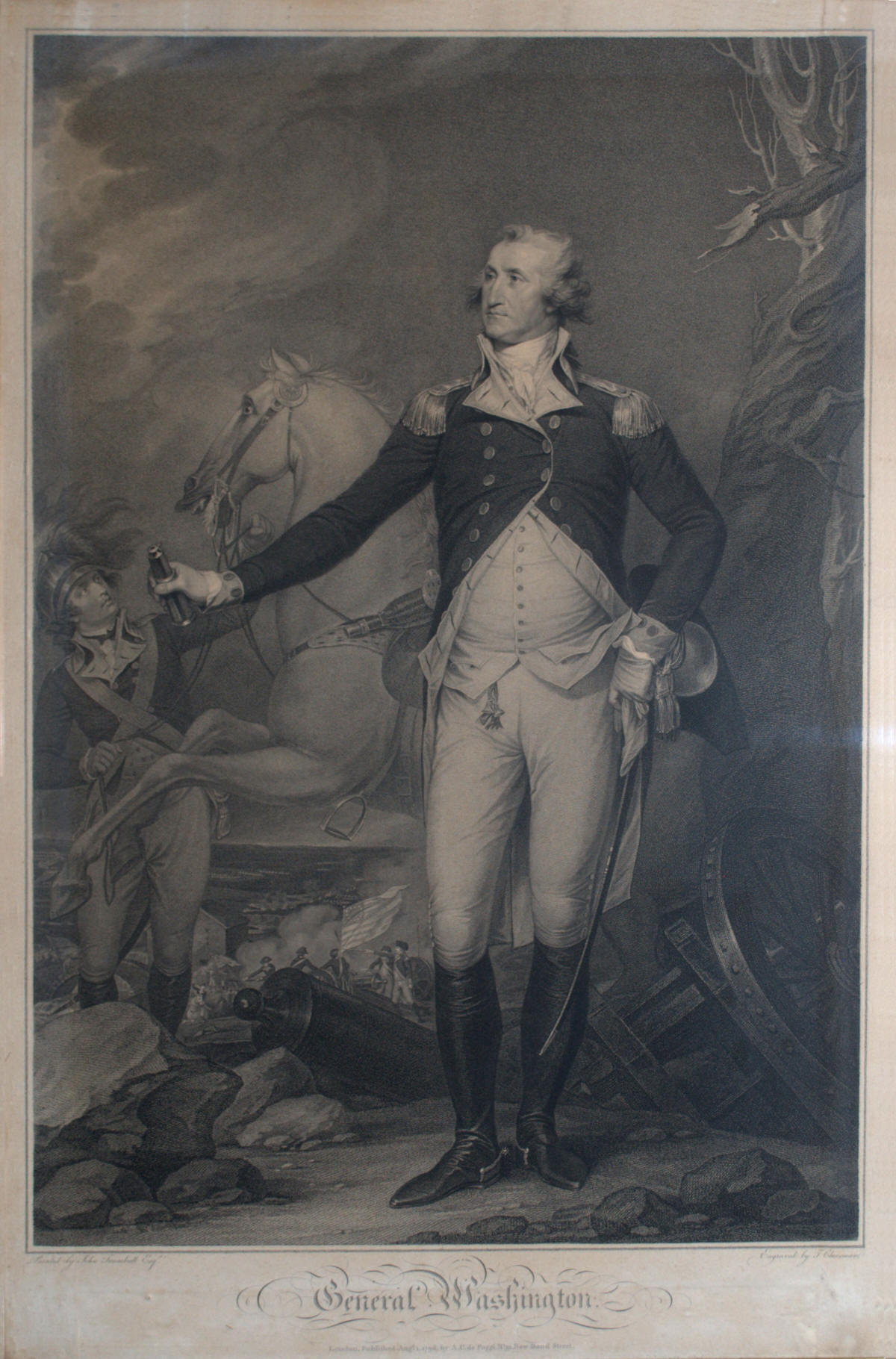 |
General Washington.
Painted by John Trumbull
Esqe. Engraved by T.
Cheesman. London. Published
Augt. 1, 1796, by A. C. De
Poggi. No. 91, New Bond
Street. After
John Trumbull. This
engraving was supervised by
Trumbull while he was in
London along with John Jay
to negotiate treaties with
the British. Upon his
return, Trumbull gifted a
copy of the engraving to
Martha Washington, which
still hangs in the entryway
to Mount Vernon to this day.
This engraving matches the
description of Hart 104, but differs from
the examples cited in Baker and Carson in that this
has a date of August 1,
1796, whereas other examples
have different dates, no
date, or no publisher
information. (see Baker No.
141; Hart No. 104, 105; Carson
Nos. 279, 280, 281, 282,
283)
After: John Trumbull
Engraver: Thomas Cheesman
Location: London
Year: 1796
Reference: Carson 279, 280,
281, 282, 283; Hart No. 104,
105;
Baker No. 141) |
|
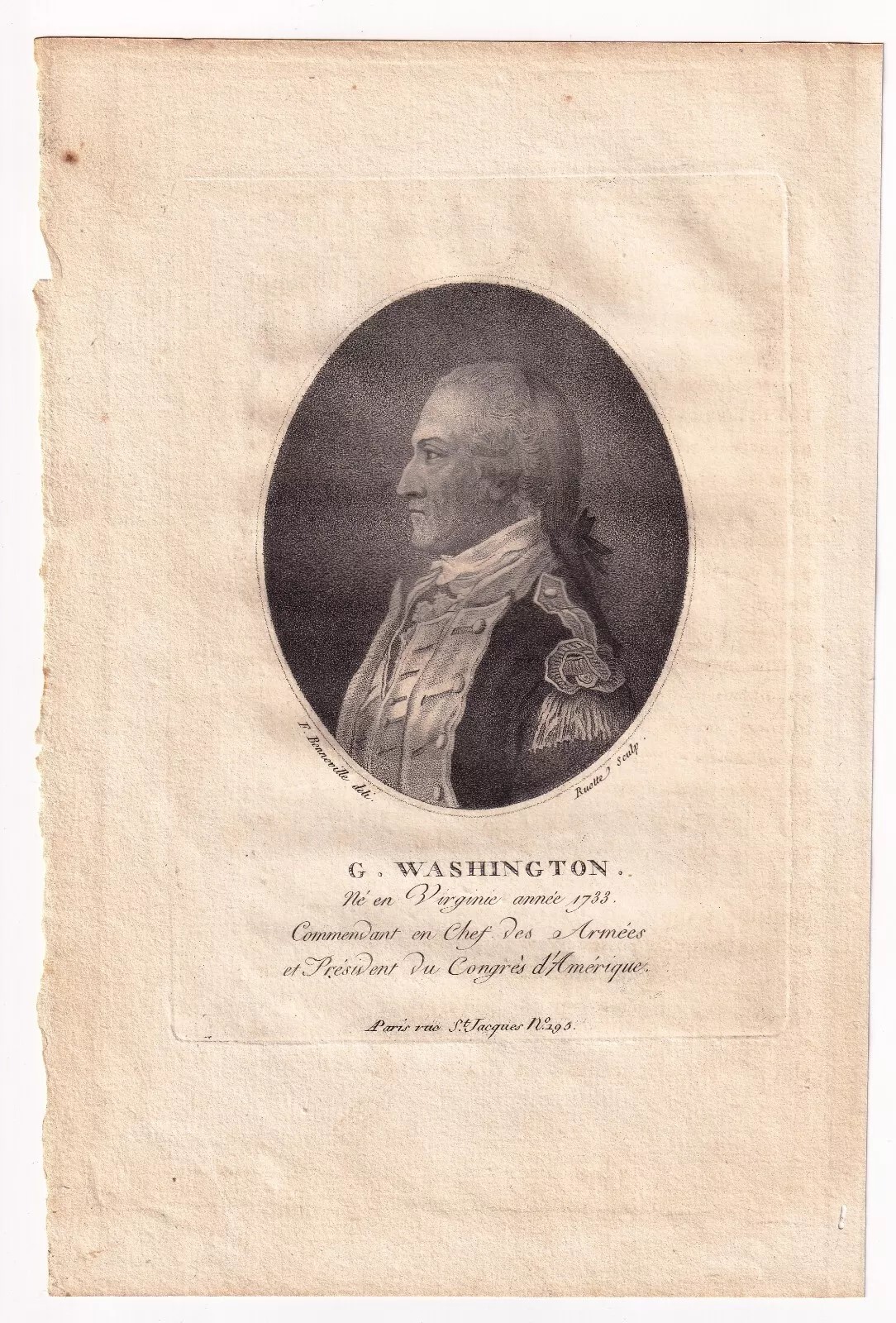 |
G. Washington.
Ne' en Virginie annee 1733.
Commandant en Chef des
Armees et President du
Congres d'Amerique. After
Joseph Wright. F.
Bonneville deli. Ruotte
sculp. Paris Rue St Jacques
No 195. The portrait
is taken from
Portraits of Famous Figures
of the Revolution, with a
Historical Table and Notes
by P. Quenard. Paris,
published by the author,
François Bonneville,
1796-1797
After: Joseph Wright
Location: Paris
Year: 1796
Reference: Baker 69, Hart
172b, Carson 132 |
|
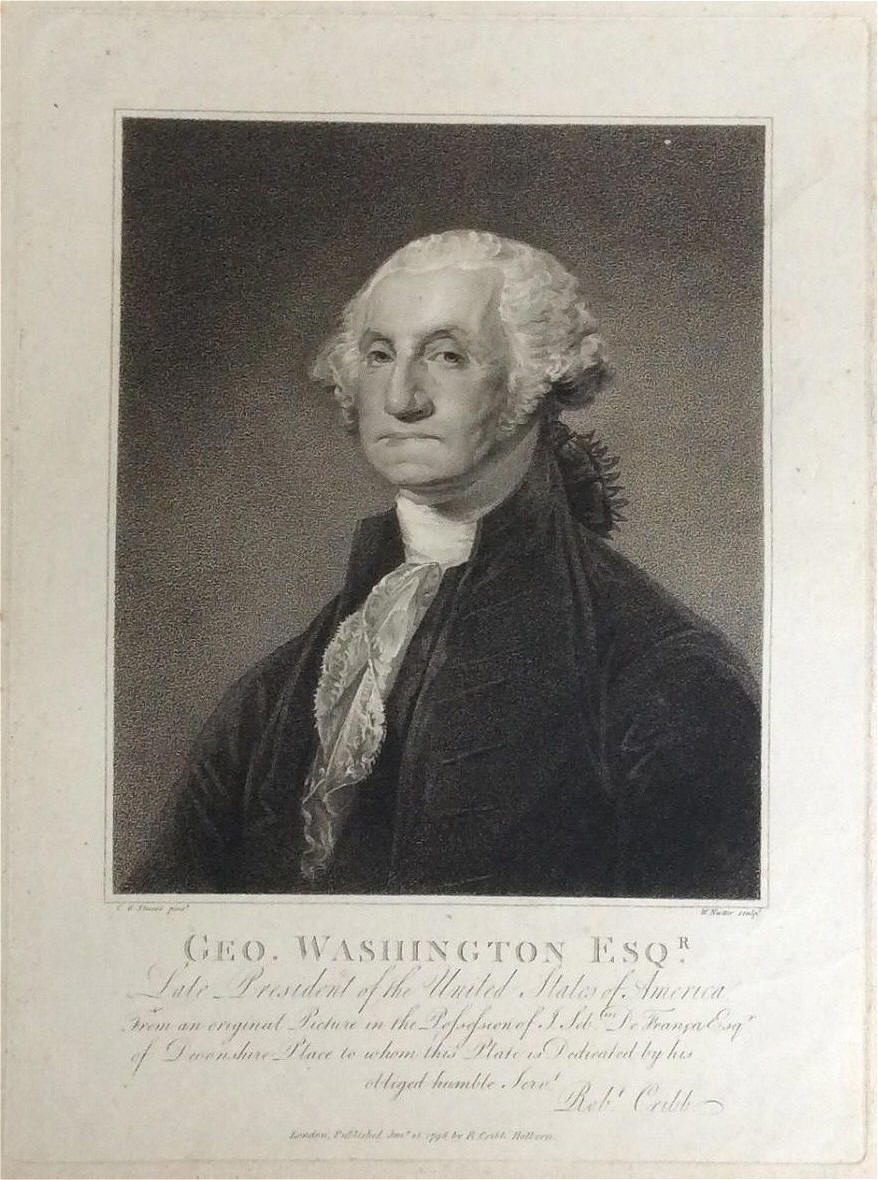 |
GEO. WASHINGTON ESQR.
Late President of the
United States of America.
From an original picture in
the possession of J. Seban.
[i.e. Sebastian] De Franca
Esqr of Devonshire Place to
whom this plate is dedicated
by his obliged humble servt.
Robt. Cribb / / C.G. Stuart
pinxt. ; W. Nutter sculpt.
This fine stipple engraving
by William Nutter is based
on Gilbert Stuart's famed
Athenaeum portrait of
Washington. Stuart's
original painting, made in
the presence of Washington,
was left incomplete, but
Stuart used the original to
paint many other copies of
the portrait, including the
first copy which he
presented to George and
Martha Washington. This is
the finest early engraving
of the portrait, published
in London in January, 1798,
during Washington's
lifetime. Baker lists the
engraving as "rare",
the Whelen Collection as "very rare". The
engraving was also printed
in color.
After: Gilbert Stuart
Engraver: William Nutter
Location: London
Year: January 15, 1798
Reference: Baker 294, Hart
428 (First State). |
|
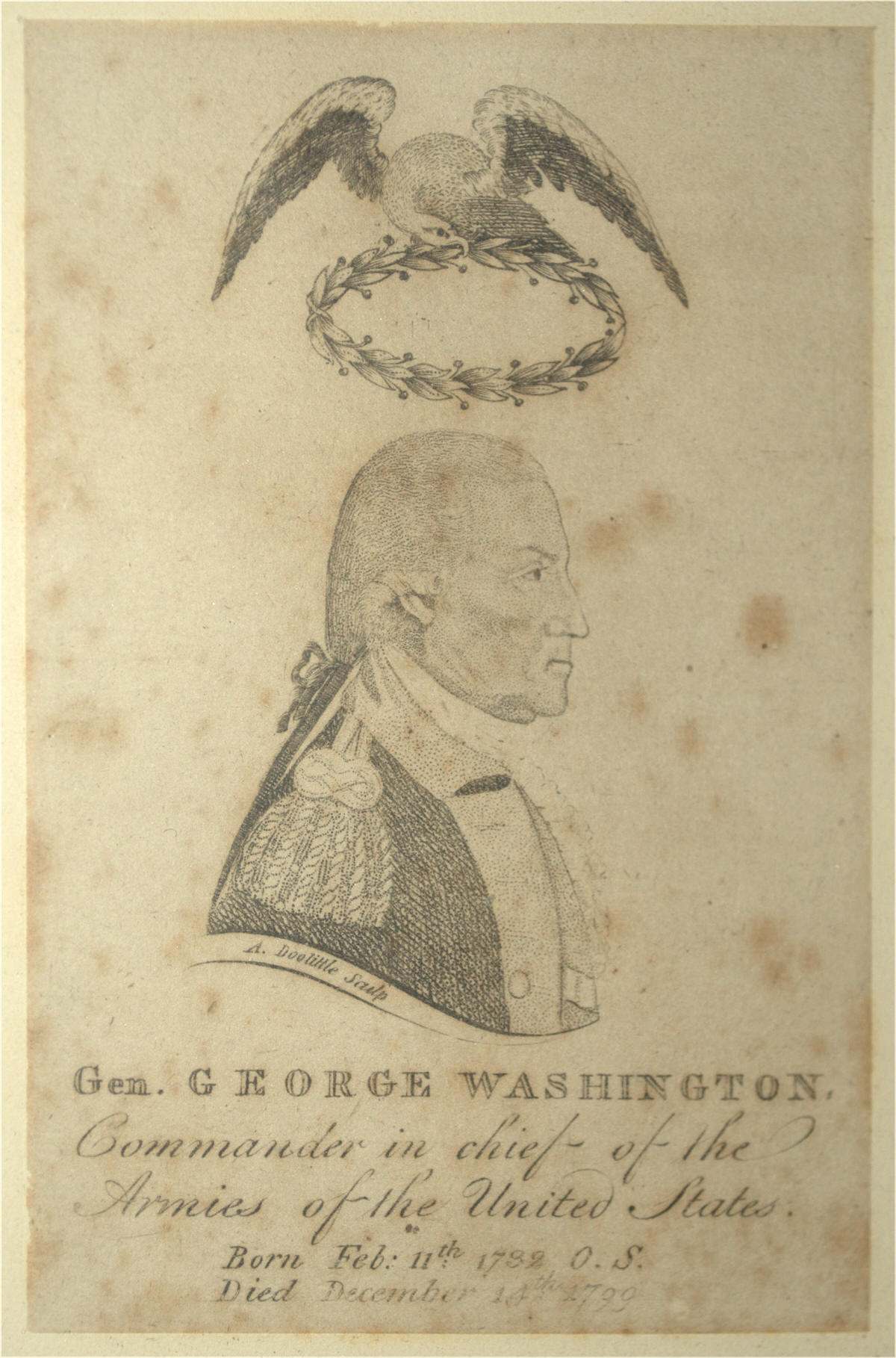 |
Gen. General Washington.
Commander in chief of the
Armies of the United States.
Born Feb 11th 1732 O.S. Died
December 17th 1799
After
Joseph Wright.
Published as the
frontispiece to "The Majesty
and Morality of created Gods
Illustrated and Improved" by
Benjamin Trumbull, published
in New Haven, Connecticut,
1800. Baker No. 81,
"extremely rare"; Hart No.
145. Carson No. 145
After: Joseph Wright
Engraver: Amos Doolittle
Location: New Haven,
Connecticut
Year: 1800
Reference: Carson No. 145;
Hart No. 145; Baker No. 81 |
|
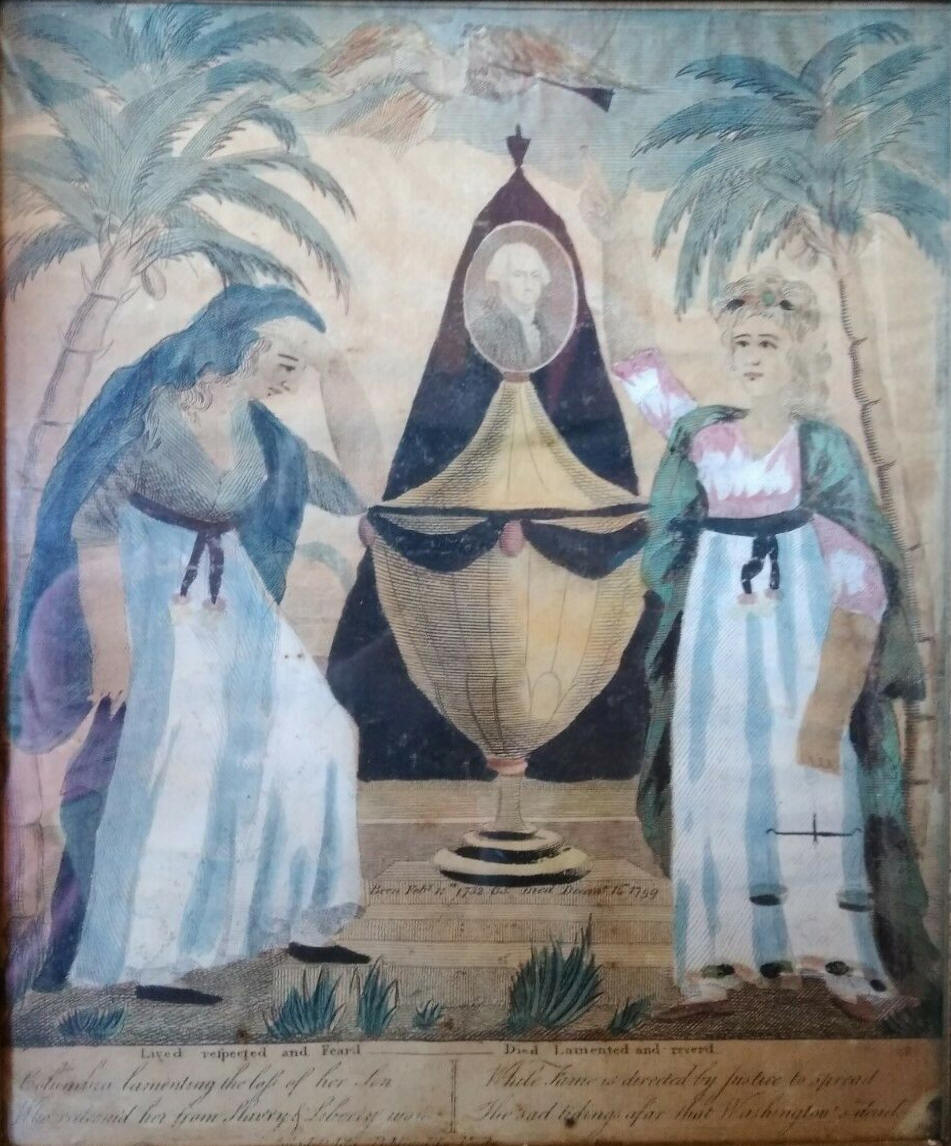 |
Lived respected and
Fear'd---Died Lamented and
rever'd.
Philadelphia Published by
Pember [& Luzarder], 1800.
This very rare mourning
engraving was hastily
published in Philadelphia in
1800 very soon after the
death of George Washington
on December 14, 1799.
One of a pair of engravings
published by Edward Pember
and James Luzarder, along
with a companion engraving,
"G. Washington in his Last
Illness". Based on Wendy
Wick's research,
handkerchiefs based on this
pair of engravings were
imported from Scotland and
advertised in newspapers by
July 24, 1800, indicating
that these engravings were
made early in 1800. The
first state of this
engraving featured a
Wright-type portrait of
Washington while the second
state (this example)
featured a Stuart-type
portrait. Baker noted just
one impression at the time
of his writing. One example
is present at Winterthur.
After: Gilbert Stuart
Engraver: Unknown
Location: United States
Year: 1800
Reference: Wick 72, Baker
408, Hart 644, Fowble 206 |
|
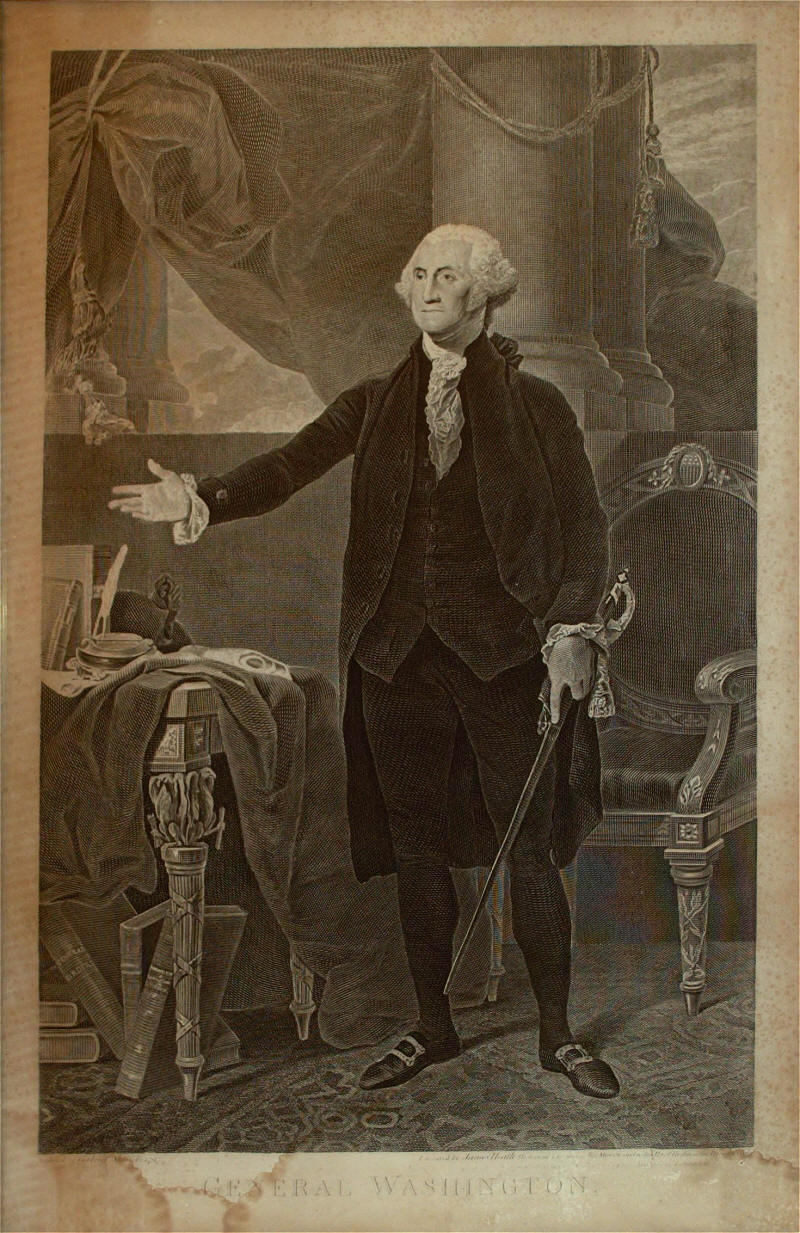 |
GENERAL WASHINGTON.
After Gilbert Stuart.
The Lansdowne Portrait,
depicting George Washington
as President. Engraved by
James Heath, this engraving
was contentious in the day
because Heath made the
engraving shortly following
the death of George
Washington in 1799, and
published it without the
permission of Gilbert
Stuart, the artist, who
planned to publish his own
engraving of the portrait
and was enraged that Heath's
engraving predated his own.
The Stuart painting from
which Heath made his
engraving was in the
collection of The Marquis of
Lansdowne, given as a gift
by wealthy Philadelphia
merchant and patriot William
Bingham.
After: Gilbert Stuart
Engraver: James Heath
Location: London
Year: February 1, 1800
Reference: Baker 250, Hart
285. |
|
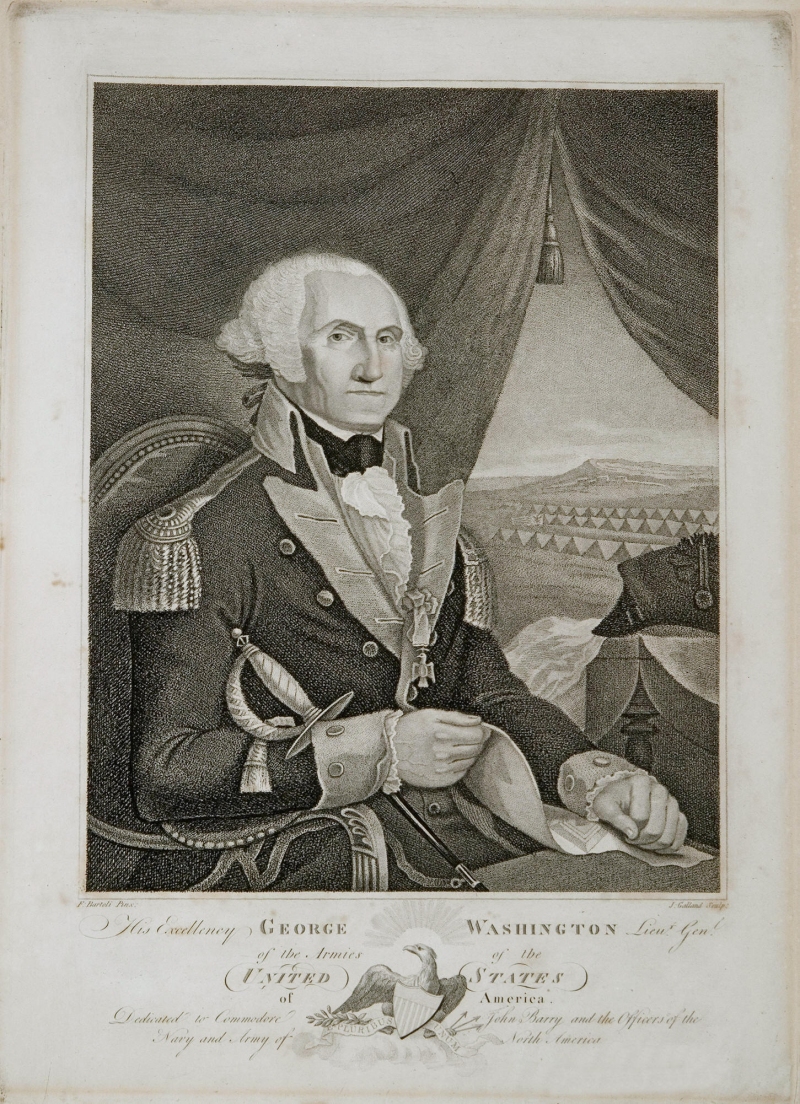 |
His Excellency GEORGE
WASHINGTON Liet. Genl.
of the Armies of the UNITED
STATES of America.
Dedicated to Commodore
John Barry and the Officers
of the Navy and Army of
North America. Although
the original of this
engraving was attributed as
being painted by F. Bartoli,
though this artist is
unknown. The plate of this
engraving was originally
engraved by David Edwin, and
was dedicated to "the lovers
of their country and firm
supporters of the
Constitution", and was
published in Philadelphia
circa 1798 [Hart 788]. A
later issue changed to the
engraver to J. Galland and
changed the dedication to
Commodore John Barry, in the
1802-1810 period, and was
printed "By John McElwee"
[Hart 789]. A third variant
erased John McElwee and
substituded "By Ferrai &
Dupin, Baltimore" [Hart
789a]. Finally, a fourth
variant (this example),
erased "By Ferrai & Dupin,
Baltimore" completely, and
is believed printed circa
1880 [Hart 789b].
After: Gilbert Stuart
Engraver: J. Galland Sculp.,
F. Bartoli Pinx.
Location: United States
Year: 1798, 1802-1810, 1880
Reference: Baker 228, Hart
789b. |
|
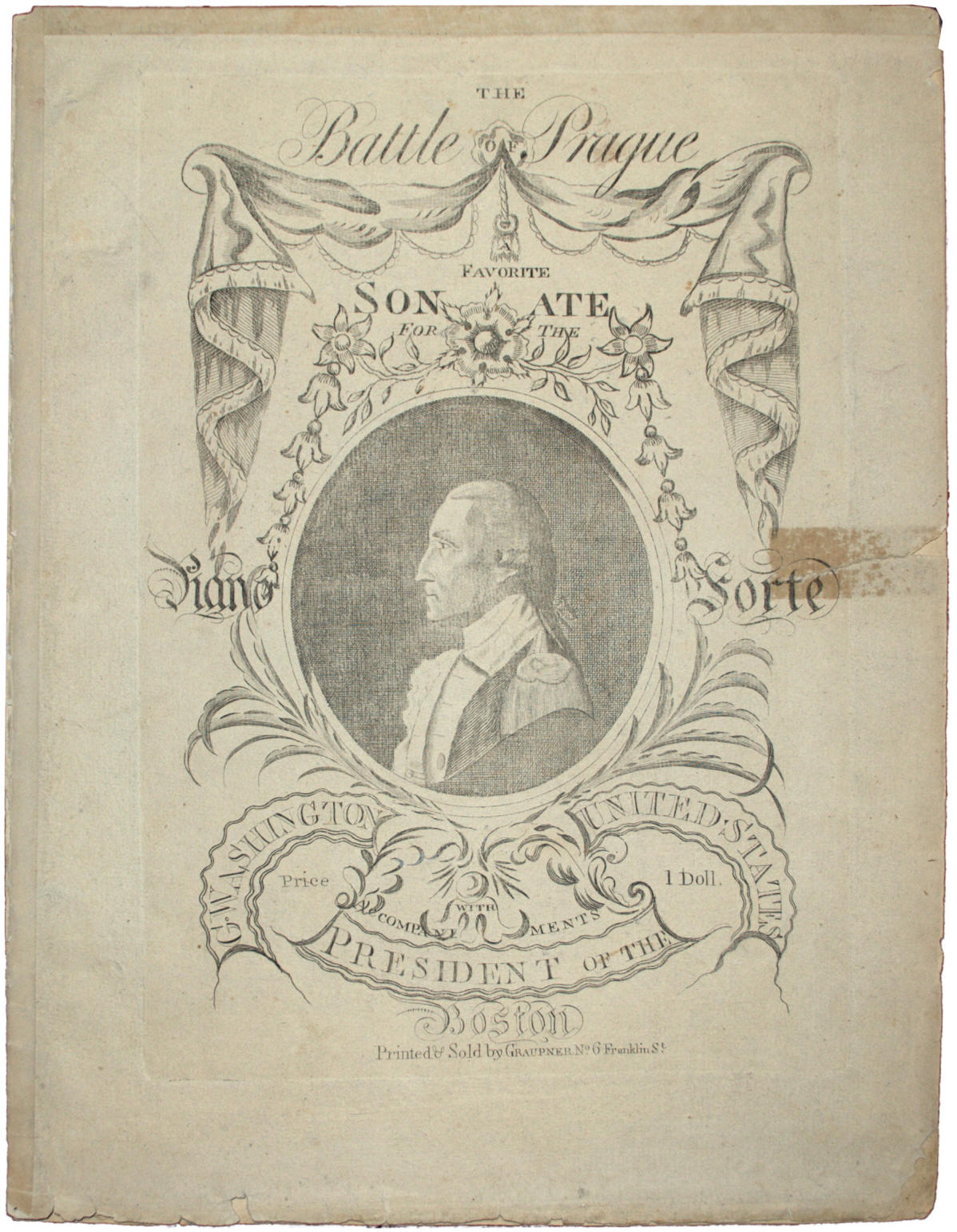 |
G. Washington President of
the United States, The
Battle of Prague A Favorite
Sonate For The Piano Forte
With Accompaniments, Boston
Printed & Sold by Graupner
No. 6 Franklin St.
After Joseph Wright. A
very rare complete set of
sheet music dedicated to
George Washington.
Baker noted that "only one
impression has come under
the notice of the writer
[Baker]" and that the
engraving of Washington is
"from the Etching by
Wright". Hart No. 153a,
where Hart notes that the
engraving is the same as
Hart No. 153 which is a
separate non-sheet music
strike of this Washington
engraving, accompanied by a
manuscript note that it was
engraved by an S. Wetherbee.
Not listed in Carson.
After: Joseph Wright
Engraver: Samuel Wetherbee
Location: Boston
Year: Circa 1810
Reference: Baker No. 82;
Hart No. 153a |
|
|
|
 |
|
|
|
|

